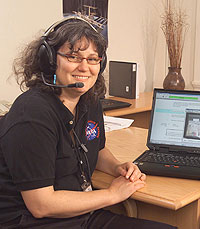July 11, 2005
Space-station astronauts test voice-operated computer system developed under UC contract with NASA
By Tim Stephens
Astronauts aboard the International Space Station are testing a sophisticated voice-operated computer system designed to guide them through complex procedures.

Project scientist Beth Ann
Hockey leads a diverse team of researchers collaborating on the Clarissa project at NASA Ames.
Photo: NASA |
This advanced spoken-dialogue system, called Clarissa, reads the steps of a procedure to an astronaut, answers questions, and responds to spoken commands.
"Instead of scrolling through written procedures on a laptop or handheld computer, they can wear a headset and have their hands and eyes free to focus on the procedure," said project scientist Beth Ann Hockey.
The spoken-dialogue system is one of many NASA projects being carried out through a unique partnership between UCSC and the NASA Ames Research Center. An agreement between UC and NASA in 2003 established the University Affiliated Research Center (UARC) at NASA Ames, where UCSC now manages a wide range of mission-oriented research tasks.
Hockey, a UCSC employee working at NASA Ames under the UARC contract, leads a diverse team of researchers collaborating on the Clarissa project at NASA Ames. Project manager Kim Farrell is with the QSS Group, a private contractor, and lead implementer Manny Rayner is with the International Computer Science Institute, a nonprofit research institute affiliated with UC Berkeley.
The Clarissa spoken-dialogue system was installed on the International Space Station in December, and astronaut John Phillips successfully tested it onboard the space station on June 27. NASA also demonstrated the system at a meeting of the Association for Computational Linguistics in Ann Arbor, Michigan, in June.
In addition to reading procedures to the astronauts, Clarissa can answer simple questions, take notes, and display pictures.
"Even in normal circumstances it can be a pain to break from your work to flip through pages or scroll through instructions on a screen. But in microgravity it's a lot worse, because as soon as you let go of something it floats away," Hockey said.
The system could potentially increase the efficiency with which astronauts carry out thousands of operations aboard the space station. These include complex procedures to maintain life-support systems, check out space suits, conduct science experiments, and perform medical exams. Plans call for eventually making Clarissa a feature with all procedures aboard the space station.
Clarissa's capabilities include: allowing the user to correct or undo commands; distinguishing speech intended for it from speech among other people; giving the user spoken context-sensitive help; and a "challenge-verify" mode for safety-critical procedures that confirms with the user that each step has been completed and warns about skipped steps.
These capabilities pave the way for other kinds of spoken-voice interfaces, Hockey said. For example, spoken interaction with robotic assistants may be possible in the future.
Additional information about UARC research on spoken-dialogue systems can be found on the UARC web site. More information about Clarissa is available from NASA at tc.arc.nasa.gov/projects/clarissa.
 Email this story
Email this story
 Printer-friendly version
Printer-friendly version
 Return to Front Page
Return to Front Page